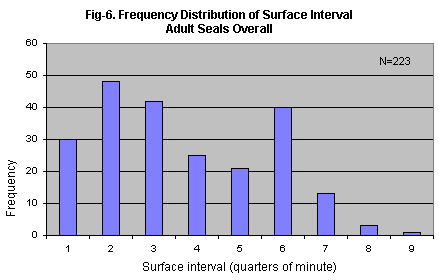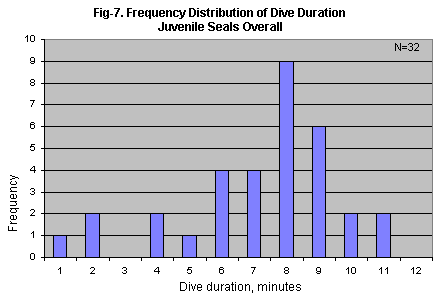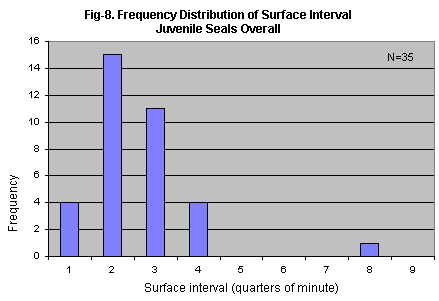Abstract
Diving behaviour of Mediterranean monk seals in Turkish waters was observed opportunistically from 1993 to 1998. Twenty separate diving episodes, each comprising many individual dives, were recorded. Eighteen of these events involved adults; the remaining two involved juveniles. Among the 18 observations of adults, 15 produced complete data for 3 previously identified (1 male and 2 females) and 4 unidentified animals. A total of 220 dives and 223 surface intervals were recorded. Mean dive duration and mean surface interval for adult animals were 384.9 seconds (6.4 min) and 48.9 seconds (0.81 min), respectively. The two observations of a juvenile monk seal recorded 32 dives and 35 surface interval measurements. Mean dive duration of juveniles was 407.9 seconds (6.8 min) with a mean surface interval of 32.6 seconds (0.54 min).
Introduction
Little is known about the diving patterns and feeding behaviour of the Mediterranean monk seal (Monachus monachus), which survives mainly on the coasts of Greece and Turkey in the Eastern Mediterranean, and on the coasts of Western Sahara and Madeira in the Northeast Atlantic Ocean [Distribution map].
Along the Atlantic coast of the Western Sahara, Gazo (1996) used time depth recorders (TDRs) to study the diving behaviour of nursing and recently weaned Mediterranean monk seal pups. One nursing pup had mean and maximum dive durations of 51.6 and 320 seconds, respectively. Two recently weaned pups had mean diving durations of 112.9 and 91.1 seconds, and maximum dive durations of 330 and 590 seconds, respectively. In a subsequent study Gazo (1997) used a TDR to study diving behaviour of an adult male monk seal. The animal dove to a maximum depth of 58 m; maximum dive duration was 8 minutes. Most dives were shallow (less than 8 m), with only 5% exceeding 50 m.
On the Desertas Islands, Madeira, Costa Neves (1998) provided preliminary observations on the diving patterns and feeding behaviour of monk seals observed from selected lookout points. He observed two distinctive diving patterns in foraging monk seals: “spot feeding,” where seals dove continuously in the same location close to shore for up to several hours, spending up to 12 minutes underwater, and about one minute on the surface before initiating the next dive; and “transit feeding,” where seals covered considerable distances along the shoreline, with dive durations up to seven minutes, before resurfacing. Spot feeding was usually observed in solitary adults in relatively shallow water not exceeding 6 m. Immature seals were only observed “transit feeding.”
Until now, no information on the dive pattern and feeding activity of the Mediterranean monk seal in the Mediterranean basin has been available. Here we report observations of dive durations and surface intervals of Mediterranean monk seals observed opportunistically along the coast of Turkey.
Methods
Observations of free ranging adult and juvenile monk seals were made from selected lookout points on remote islands and the mainland of the Turkish Aegean between May 1993 and September 1998. Observation points included: the western cliffs of Büyük Kiremit Island off Yalikavak, Çavus Island off Gümüslük, Bodrum, SW Turkey, and the Siren Rocks of Orak Island off Foça, W. Turkey (Figure 1). Observations from the mainland were obtained along the coast of Kanlikaya cliffs, 4 km north of Karaburun town (D1), the Ayani coast, 4 km north of Foça (D17 and D18) and Kizilkuyruk Cape at the Western tip of Fethiye bay (DX). Observations were made in regions where repeated monk seal sightings had occurred, and when animals were encountered during scheduled surveys or routine fieldwork.
 |
|
Figure 1. Observation sites
(click to enlarge)
|
Researchers selected locations on cliffs with the widest angle of view to facilitate observations of monk seal diving behaviour (Figure 2). A total of 17 observers recorded diving behaviour, with 2 to 6 observers participating on each occasion. The observers attempted to hide themselves among rocks or vegetation, where available, in order not to be seen by the seals. During observations of diving activity, times of every dive and surfacing event were recorded. Binoculars (8x to 12x), cameras with zoom lenses (24-50 mm and 75-300 mm), and a telephoto lens (600 mm) were used to identify individual seals and to make the observations. Sex of individual seals was identified on the basis of previous field experience, with conclusions being verified against information on morphological differences provided by Samaranch and Gonzales (1998). Dives were characterised as “spot feeding” dives or “transit” dives following Costa Neves (1998).
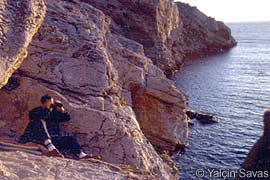 |
| Figure 2. A researcher at a cliff top observation post on Karaada Island, Bodrum. |
In three cases, researchers intruded upon diving seals. One observer made scuba dives to observe the behaviour of the adult seal “Susa?” (observation D10b) and the juvenile seal “Fatma” (D17) on the north coast of Çavus Island, and on the Ayani coast near Foça, respectively. In the case of observation D13a, researchers took photos from an inflatable boat for a short period of time, while remaining at least 50 m from the seal, “Disi Korsan,” at the Siren Rocks of Orak Island (Figure 4). In all three cases, the seals continued their diving activity, regardless of the presence of human observers.
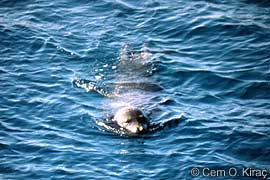 |
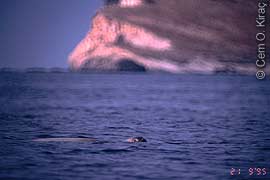 |
| Figure 3. Susa at Büyük Kiremit Island |
Figure 4. Disi Korsan at the Siren Rocks |
For each individual dive observed, dive duration and surface intervals between dives were recorded and mean, median and maximum dive duration, and mean and median surface intervals were calculated. In addition, the data were pooled for all animals observed, in order to calculate mean, median, and maximum dive duration, and mean and median surface intervals for all dives combined.
Results
A total of 20 diving episodes, each comprising a series of individual dives, were observed (Table 1). Three of these had incomplete data and were not used in any calculations (DX, DY, DZ). The remaining 17 diving episodes with complete data involved 15 adult monk seals (Table 2) and 2 juveniles (Table 3), and spanned 3319 minutes (55.3 hours) of observations. All the observations were made between dawn and dusk and in the majority of the spot dive observations (D4, D5, D9, D10b, D13a, D15, D16, D17 and D18) seals left the dive area near or at dusk.
These seventeen diving episodes were used to estimate mean, median, and maximum dive durations, and mean and median surface intervals for each of the animals. Dives less than or equal to 25 seconds were considered too brief to be classified as a dive and were not included in the estimation of dive duration. In addition, the mean and median dive duration and surface interval for all adults combined (15 seals, 223 surface intervals and 220 dives), and all juveniles combined (2 animals, 35 surface intervals, and 32 dives) were also calculated. The ratio of mean dive duration to mean surface interval (d/s) for each diving episode was also calculated, for both adult and juvenile seals combined.
Table 1. The location, dive type, name/field code of individual seals, sex and date of diving observations.
| No. |
Obs. |
Location |
Type |
Seal |
Sex |
Date |
| 1 |
D1 |
Kanlikaya to Karaburun |
Transit |
F1 |
- |
28.05.1993 |
| 2 |
D4 |
B. Kiremit Island |
Spot |
Susa |
M |
15.01.1994 |
| 3 |
D5 |
B. Kiremit Island |
Spot |
Susa |
M |
16.01.1994 |
| 4 |
D6 |
B. Kiremit Island |
Spot |
Susa |
M |
17.01.1994 |
| 5 |
D8 |
Orak Isl./Siren Rocks |
Spot |
F2 |
- |
05.04.1994 |
| 6 |
D9 |
Çavus Isl. |
Spot |
Susa? |
M |
05.06.1994 |
| 7 |
D10a |
Çavus Isl. |
Spot |
Susa? |
M |
06.06.1994 |
| 8 |
D10b |
Çavus Isl. |
Spot |
Susa? |
M |
06.06.1994 |
| 9 |
D11 |
Orak to Kartdere |
Transit |
F3 |
- |
13.08.1994 |
| 10 |
D12 |
Orak Isl./Siren Rocks |
Spot |
Sühendan |
F |
18.11.1994 |
| 11 |
D13a |
Orak Isl./Siren Rocks |
Spot |
Disi Korsan |
F |
21.09.1995 |
| 12 |
D13b |
Orak to Incir |
Transit |
Disi Korsan |
F |
21.09.1995 |
| 13 |
D14 |
Orak Isl./Siren Rocks |
Spot |
Sühendan |
F |
30.09.1995 |
| 14 |
D15 |
Orak Isl./Siren Rocks |
Spot |
F4 |
- |
01.10.1995 |
| 15 |
D16 |
B. Kiremit Island |
Spot |
Susa |
M |
01.09.1996 |
| 16 |
D17 |
Ayani |
Spot |
Fatma (Juv) |
- |
31.07.1998 |
| 17 |
D18 |
Ayani |
Spot |
Fatma (Juv) |
- |
06.09.1998 |
| 18 |
DX |
Kizilkuyruk Cape |
Spot |
Piyade |
M |
24.09.1994 |
| 19 |
DY |
Orak Isl./Siren Rocks |
Spot |
F5 |
- |
26.05.1995 |
| 20 |
DZ |
Orak Isl./Siren Rocks |
Spot |
F6 |
- |
05.10.1995 |
Table 2. Maximum, mean and median dive duration and mean and median surface interval and d/s ratio of all observations for adult seals. OP= Observation period of seals’ dive; d/s= divemean/surfacemean factor.
|







